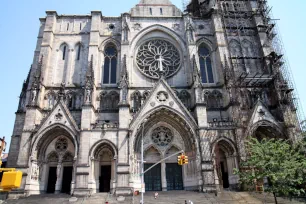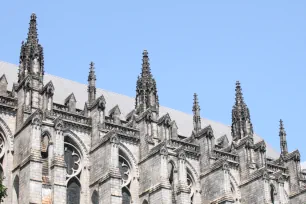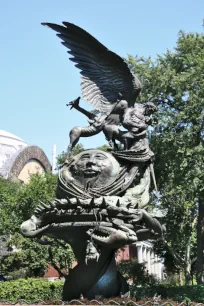In 1887, the Episcopalians decided to build a grand cathedral in New York City, dedicated to St. John the Divine. It isn’t quite finished yet!
History
In the beginning



In response to the construction of the Catholic Church’s amazing St. Patrick’s Cathedral at 50th and Fifth Avenue, the Episcopal Diocese of New York decided to build one of its own. Thus began the plans for The Cathedral of St. John the Divine.
In 1887, he Episcopalians held a contest to choose the best design for their new structure. The prize went to the young firm of Heins and LaFarge, who chose a Romanesque/Byzantine design for the cathedral. A site in the Morningside Heights district of the city was acquired by the congregation, situated between 110th and 113th Streets between Amsterdam Avenue and Morningside Drive.
The cornerstone was laid in 1892, but by the turn-of-the-century, only the crypt and foundation were complete. Church officials also began having doubts about the design of the church, now preferring a Gothic cathedral to the original Byzantine design. When George Heins died in 1907, the diocese eventually hired Ralph Cram, who promoted the change to a Gothic design.



By 1911, the choir and the crossing with its four huge arches were complete. The renowned mason Rafael Guastavino built a dome of tile, 162 feet (49 meters) high at the apex, to cover the crossing. Originally, a spire was planned for that location.
Work continued for the next thirty years, and the cathedral was considered far enough along for a dedication ceremony to be held in November 1941, shortly before America entered World War II. Cram’s Gothic design was regarded by many as “stiff”, though, at 601 feet / 183 meters, the nave won kudos for being the longest of any cathedral in existence.
Worked stopped just a week after the ceremony was held, when the Japanese attacked Pearl Harbor.
The Later Years
In 1979, under the leadership of Reverend James Parks Morton, building commenced once again. This time, the construction workers included urban youth, in accordance with an apprenticeship program spearheaded by Morton. The south tower was raised about 200 feet (61 meters) and money ran out once again. A fire in the gift shop and north transept in December 2001 added further insult to injury.
The cathedral is now two-thirds complete, though the towers, the transepts, the Great Crossing and the choir roof still remain incomplete. Experts estimate that it would take at least one hundred years and in excess of $100 million to complete the cathedral according to Cram’s drawings. No further construction is currently planned, and it remains to be seen if the church will ever be completed. This has led to the nickname “St. John the Unfinished”.
The World’s Largest
Even unfinished, the cathedral has already become a tourist attraction thanks to its status as the largest cathedral in the world. It is not the world’s largest church, though, that title still belongs to the Saint Peter’s Basilica in Rome.
Peace Fountain
Near the cathedral is a controversial sculpture known as the Peace Fountain. The sculpture by Gregg Wyatt depicts the struggle between good and evil. Its design refers to the grotesques often found at medieval cathedrals.
- Next: Federal Hall
- More Sights & Attractions in New York

